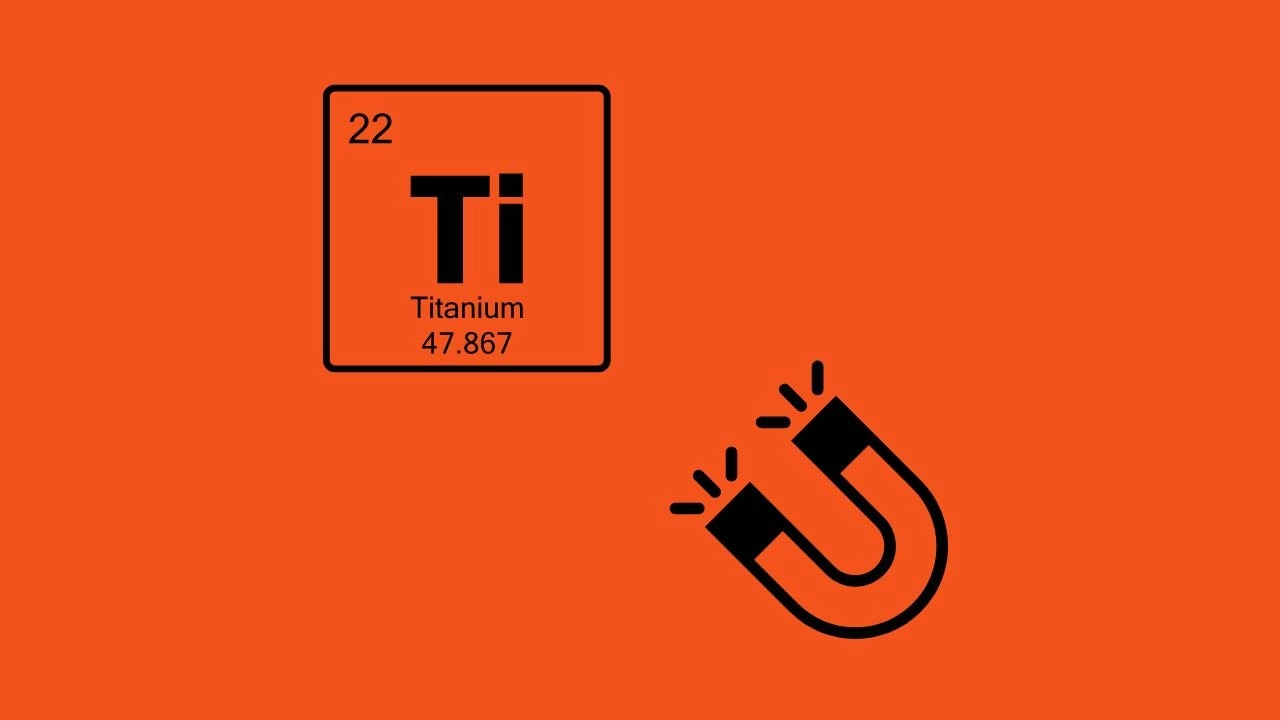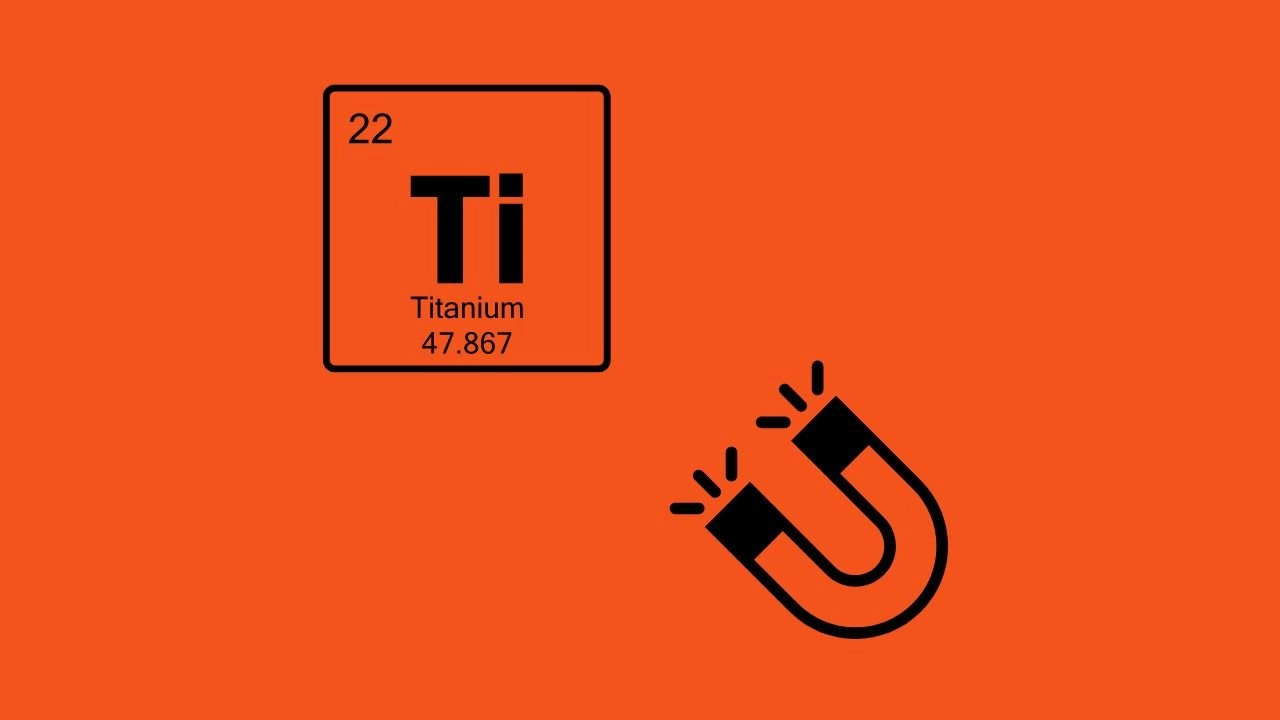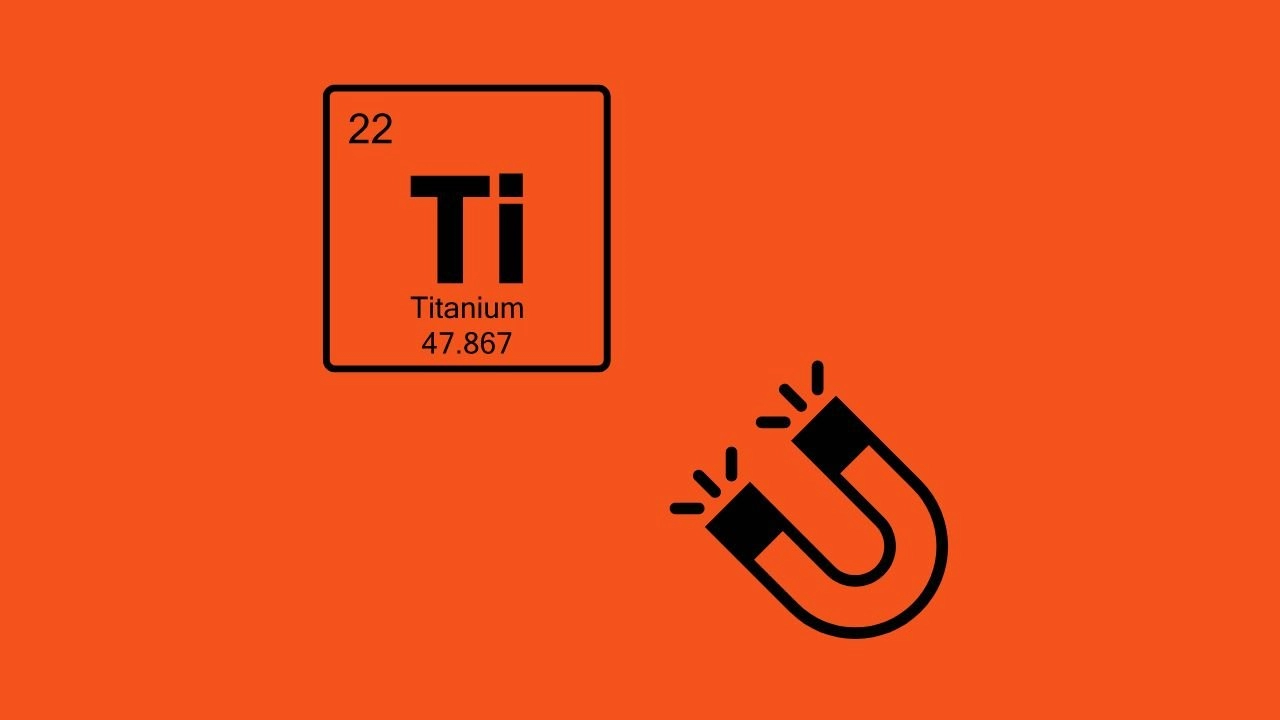Discover if titanium is magnetic with clear scientific insights on its paramagnetic properties and uses in medical and aerospace industries.
Understanding Magnetism Basic Concepts
Magnetism is a physical phenomenon caused by the motion of electric charges, resulting in attractive or repulsive forces between objects. It is most commonly experienced through magnets that attract metals like iron. Magnetism arises from the alignment of tiny magnetic moments associated with electrons in atoms.
There are three main types of magnetism in materials:
- Ferromagnetism: Strong magnetic behavior where atomic magnetic moments align parallel to each other, creating permanent magnets. Examples include iron, nickel, and cobalt.
- Paramagnetism: Weak attraction to magnetic fields due to unpaired electrons, but without permanent magnetism. Materials return to a non-magnetic state once the external field is removed.
- Diamagnetism: A very weak repulsion from magnetic fields caused by changes in electron orbital motion. All materials exhibit diamagnetism to some extent, but it is generally overshadowed by other magnetic effects.
Metals interact differently with magnetic fields based on these properties. Ferromagnetic metals respond strongly and remain magnetized, paramagnetic metals are slightly attracted only while in a magnetic field, and diamagnetic metals repel magnetic fields weakly. Understanding these interactions is essential to grasp how various metals, including titanium, behave in magnetic environments.
The Magnetic Properties of Titanium

Titanium sits in the transition metals section of the periodic table, with an electron configuration that influences how it reacts to magnetic fields. Unlike ferromagnetic metals such as iron or nickel, titanium does not have unpaired electrons that would create a strong magnetic attraction.
Titanium is classified as a paramagnetic metal, which means it shows a very weak attraction to magnetic fields. This is quite different from diamagnetic materials, which actually repel magnetic fields slightly. In simple terms, pure titanium is not magnetic in the way most people think of magnets—it won’t stick to a fridge magnet, for example, but it can be influenced a little by very strong magnetic fields.
Scientific studies confirm that pure titanium shows only weak paramagnetism, meaning it won’t hold magnetism after the external field is removed. However, when titanium is mixed with other elements to form alloys, its magnetic behavior can change a bit. Some titanium alloys may show slightly stronger magnetic properties, especially if they contain elements like iron or nickel, but even then, they remain mostly weakly magnetic compared to traditional magnetic metals.
So, when talking about titanium magnetic or non magnetic—pure titanium is essentially non magnetic for everyday uses, but its alloys may vary depending on their specific composition.
Practical Implications Titanium’s Magnetic Behavior in Real Life
Titanium’s weak or non magnetic nature makes it highly valuable in several important industries across the United States.
Medical Implants and MRI Compatibility
- Titanium is non magnetic or very weakly paramagnetic, so it doesn’t interfere with MRI machines.
- This is why it’s a top choice for medical implants like joint replacements, screws, and plates.
- Patients with titanium implants can safely undergo MRI scans without image distortion or safety risks.
Aerospace and Military Applications
- In aerospace and military fields, non magnetic metals are crucial to avoid interference with navigation and communication devices.
- Titanium’s low magnetism reduces magnetic signature, making it ideal for aircraft parts, missiles, and submarines.
- It’s strong, lightweight, and corrosion-resistant, plus it avoids magnetic detection systems.
Industrial Uses
- Titanium’s weak magnetism works well in industries that require non magnetic tools or equipment to prevent sparks or magnetic interference.
- It’s used in chemical plants and electronics manufacturing where metal reaction to magnets can cause issues.
- Titanium is also favored for lightweight, strong structural parts.
Comparison with Other Metals
| Metal | Magnetic Behavior | Typical Uses | Notes |
|---|---|---|---|
| Titanium | Weakly paramagnetic/Non magnetic | Medical implants, aerospace, industry | MRI safe, resistant to corrosion |
| Stainless Steel | Can be magnetic or non magnetic (varies by type) | Kitchenware, machinery, implants | Some grades are magnetic |
| Aluminum | Diamagnetic (very weak) | Aerospace, transportation | Very low magnetism, lightweight |
| Nickel | Ferromagnetic (strongly magnetic) | Batteries, electronics | Highly magnetic, often alloyed |
| Steel (carbon) | Ferromagnetic | Construction, tools | Strongly magnetic, prone to rust |
Titanium’s weak magnetic properties combined with its other strengths make it a preferred metal in many areas where magnetism needs to be controlled or minimized.
Myths and Misconceptions About Titanium and Magnetism

There’s a common belief that titanium is magnetic, but that’s not true for pure titanium. Some people confuse titanium with its alloys or coated products, which can contain magnetic materials. For example, titanium mixed with iron or nickel in alloys might show some magnetic properties, leading to the misunderstanding.
Another mix-up happens with coatings or surface treatments on titanium items. Sometimes, a magnetic coating is applied for extra durability or aesthetic reasons, making the object react to magnets even though the titanium beneath isn’t magnetic.
So, when you hear “titanium is magnetic,” it’s usually because of these alloys or coatings, not pure titanium itself. Knowing the difference helps avoid confusion when choosing titanium for applications needing nonmagnetic metals.
How to Test If Your Titanium Object Is Magnetic
If you want to check whether your titanium item is magnetic, here are some simple and practical ways to do it:
Simple At-Home Tests
- Use a fridge magnet: Bring a strong magnet close to your titanium object. Pure titanium is typically non magnetic or only very weakly magnetic, so the magnet either won’t stick or will attract it very lightly.
- Watch for movement: Hold the magnet near the object and see if it moves or is pulled toward the magnet. If it moves, it might contain magnetic impurities or alloys.
- Compare with other metals: Test the same magnet on known magnetic metals like iron or steel to see how strong the pull should be.
Professional Testing Methods
- Magnetic susceptibility meters: These devices measure how much a material becomes magnetized in a magnetic field. They provide precise data on whether titanium is diamagnetic or weakly paramagnetic.
- X-ray fluorescence (XRF) analysis: This tests the alloy composition of the metal, confirming if impurities or alloy elements are affecting the magnetic properties.
- Vibrating sample magnetometer (VSM): Used in labs to measure magnetic behavior very accurately, especially helpful in industrial quality control.
These tests are useful in industries like aerospace and medical implants where knowing if titanium is magnetic matters for safety and performance.
FAQs About Titanium and Magnetism

Is titanium magnetic in all forms?
Pure titanium is not magnetic—it’s classified as a paramagnetic metal, meaning it has a very weak attraction to magnetic fields. However, some titanium alloys might show slight magnetic properties depending on what other metals are mixed in.
Can titanium be magnetized?
No, pure titanium can’t be permanently magnetized like ferromagnetic metals such as iron or nickel. It only reacts weakly when near a magnetic field but doesn’t hold magnetism on its own.
What metals are magnetic that are often confused with titanium?
Metals like stainless steel and nickel are commonly mixed up with titanium. Stainless steel, especially the magnetic types, can be attracted to magnets, while titanium remains mostly non-magnetic.
Does titanium’s magnetic property change with temperature?
Titanium’s magnetic behavior stays pretty consistent across temperatures typically encountered in everyday or industrial use. Extreme conditions might affect it slightly, but it won’t become strongly magnetic.
How does titanium compare to stainless steel regarding magnetism?
Stainless steel can be magnetic or non-magnetic depending on its type. Some grades (like ferritic steels) are magnetic, while others (like austenitic steels) aren’t. Titanium, by contrast, is much less magnetic than most stainless steels, making it ideal when non-magnetic metals are needed.
Additional Resources and References
If you want to dive deeper into titanium’s magnetic properties, here are some reliable sources and research papers that can help:
- Scientific Papers and Articles:
- “Magnetic Properties of Titanium and Its Alloys” – Published in Materials Science & Engineering.
- “Paramagnetism in Titanium” – Article available through the Journal of Applied Physics.
- Research from the National Institute of Standards and Technology (NIST) covering titanium’s electron configuration and magnetic response.
- Trusted Websites:
- The U.S. Geological Survey (USGS) offers detailed mineral data on titanium.
- American Chemical Society has accessible articles on metal magnetism and titanium’s place in the periodic table.
- MRI Safety Resources for information on titanium implants and magnetic compatibility.
- Books and Guides:
- Metals and Their Properties by J.R. Davis — Includes clear sections on magnetism in metals like titanium and stainless steel.
- Engineering Materials 1 by Michael F. Ashby — Covers basic magnetism concepts and detailed metal behavior.
- Biomedical Materials by Roger Narayan — Discusses the use of titanium in medical applications, including its magnetic properties.
Checking these will give you a solid understanding of why titanium behaves the way it does around magnets, backed by science and research.
